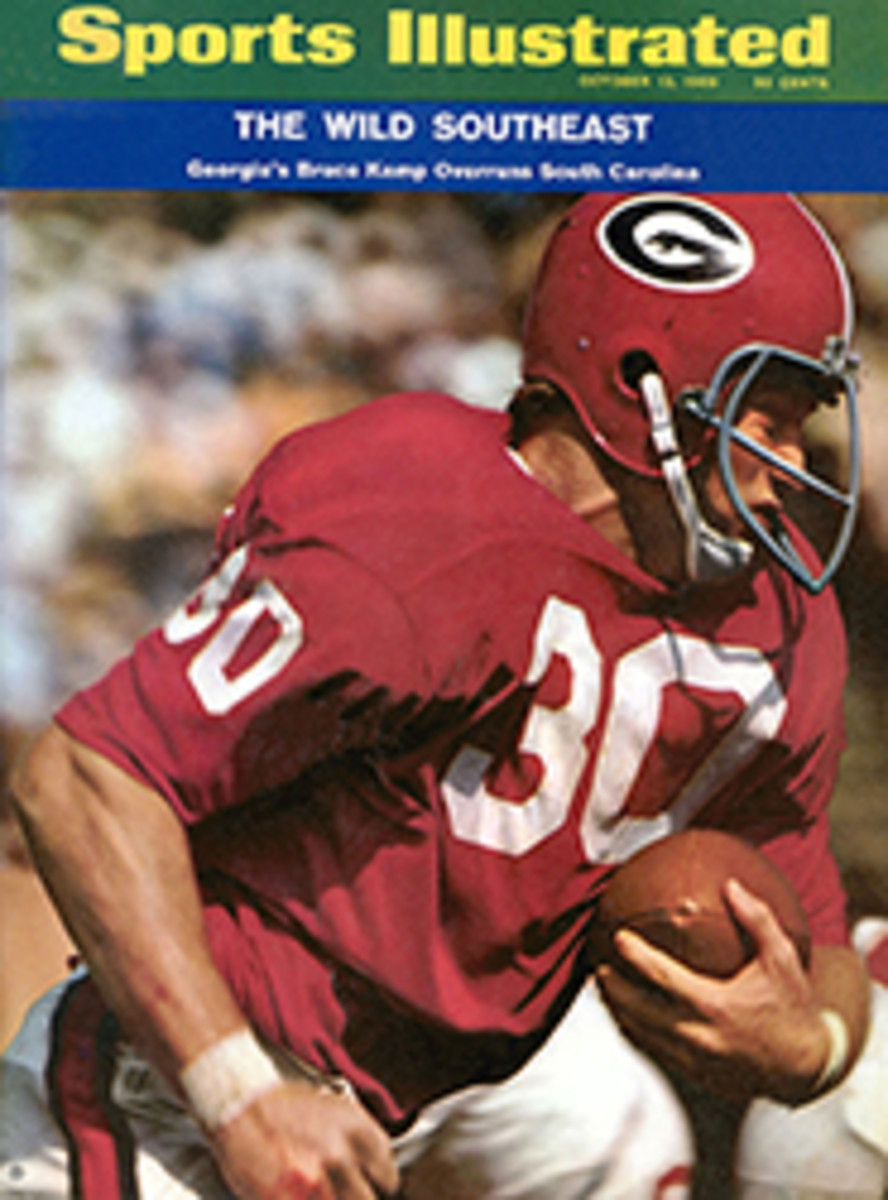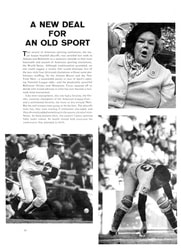
Pennies in a golden age
In what has become—quite literally—the golden age of professional golf, the scene in Singapore last week had refreshing, amateur-type overtones. A record 45 two-man teams from all over the world gathered to play, for prestige—and peanuts—in the 17th annual World Cup championship (formerly the Canada Cup). The top prize was only $1,000, a sum to be scorned in these days of dollar divotry. No fat fees were paid to lure big-ticket talent. All the pros got for showing up was a $500 "honorarium," $100 worth of walking-around money and their air fares paid to Singapore—economy class. This time they were playing not for coin but for country, and most were glad of the chance.
Take Lee Trevino. Only the week before he had blown the biggest first-prize check in golf history by frittering away a six-stroke lead on the last three holes of the Alcan Golfer of the Year tournament in Portland, Ore. That cost him a cool $40,000—the difference between $55,000 for first and $15,000 for second. But money wasn't on his mind at Singapore. "Sure, I could make a lot more back home," he said, "but this is something special, an honor, a chance to play for my country and meet a lot of nice foreign folks. I'd play in the World Cup every year if they asked me, and pay my own way, too, if I had to. I was supposed to play a round in the CBS TV Classic in Akron this week, but I told them the World Cup came first with me, and if they couldn't change their schedule, then forget about me. They changed."
Trevino got into the World Cup by the back door this year. Normally the U.S. Open and PGA champions comprise the team, but PGA winner Ray Floyd backed out, and Lee leaped at the chance to team with his close friend, Orville Moody. The galleries last week were the winners because of the switch, but the fact that a change was necessary underscores the difficulty in holding a no-money tournament these days, no matter how prestigious. Floyd wasn't the only no-show who was qualified to play. South Africa's Gary Player accepted the invitation and then reneged. Britain's Tony Jacklin and New Zealand's Bob Charles begged off on grounds of other commitments. It is no coincidence that Floyd, Player, Jacklin and Charles are all managed by golf's best-known manager, Mark McCormack. McCormack makes sure that his golfers make as much money as possible, which is only good business—especially for McCormack, who takes a cut of their winnings as well as a fee. Whether it is good for golf is another matter. In any event, all of McCormack's big names were missing at Singapore.
Tournament Director Fred Corcoran says, "This is one pro event where you don't have a dollar sign staring you in the face on every tee. It's played for the sake of international goodwill in pro golf. Now this may sound like a corny idea, but we like it, and we aim to keep it that way, big names or no."
McCormack actually may have done the International Golf Association a favor, if he did indeed withhold Floyd, by forcing the substitution of Trevino, who has the biggest and most engaging mouth in pro golf today. Lee arrived late from his Alcan fiasco, but assured everybody he was unworried. "Depressed? Not me. I always play for tomorrow. Never look back." In his only pre-tournament crack at the 6,692-yard Bukit course of the Singapore Island Country Club he shot 69 and pronounced himself ready. The lippy Trevino and the taciturn Moody (who had fine practice rounds of 67 and 66) were installed almost automatically as favorites by Singapore's hardheaded Chinese betting fraternity. After all, the U.S. had won nine team titles and six individual championships in the 16 previous matches, and U.S. pros were better acquainted with four-day pressures than any of their rivals. Canada's defending champions, Al Balding and George Knudson, were not playing well in practice, and punters plunged heavily on the "Yanks."
Sentimental favorites were the Czechoslovaks and Rumanians. Rumania was competing in the World Cup for the first time, represented by Paul Tomita and Munteanu Dumitru, co-pros at Bucharest's Cercul Diplomatic de Sporturi Baneasa. They quickly took a stranglehold on last place and stayed there, but plainly enjoyed the rare opportunity to play outside Rumania. Playing in their fifth World Cup, Czechoslovakia's Jiri Dvorak and Jan Kunsta were on the brink of disqualification when Dvorak suffered a kidney stone attack after finishing the third round. He was rushed to a hospital for treatment, then ignored the doctor's orders by playing the final round. Despite great pain Dvorak managed a gritty 80. The Czechs finished fourth from the bottom.
At the top of the list Trevino and Moody faced challenges from Argentina and a handful of Asian nations. The indestructible Roberto De Vicenzo, who helped Argentina to the first team championship back in 1953 at Montreal and who won individual honors himself in 1962 in Buenos Aires, showed up in Singapore exhausted from a 40-hour flight from home. But Roberto was soon smiling again when he heard that next year's cup matches will return to Buenos Aires. "I will be happy at home," he said, and he was hardly sad at Singapore, challenging all the way for individual honors and scoring a course-record 65 in the final round to finish second.
The Bukit course favored Asian teams, which are usually made up of short hitters and pinpoint putters. Most Asian competitors had played Bukit before on the annual Asian tour, and were familiar with the tricky Serangoon grass on the greens. Singapore's 90°-plus heat and horrendous humidity were also old hat to Asian players but took their toll of others. Trevino and Moody swore they had never played in such enervating weather, even in Texas.
The Nationalist Chinese team from Taiwan was one to watch. Taiwan had either held or shared the lead for three days at Rome last year before folding in the final round to finish fourth. Once again the Chinese were fast off the mark. Approaching the small, hard-to-hold greens well, Hsieh Yung-yo and Hsu Chi San shared first place with Trevino and Moody the first day and edged ahead of the U.S. by a single shot at the halfway point. The smooth-swinging Hsieh, who won the Singapore Open on the Bukit course last year and was low overall scorer on this year's Asian circuit of seven tournaments, put together 66 and 70 for a one-stroke lead over Moody and De Vicenzo for individual honors and the international trophy after 36 holes.
But the big surprise of the tournament was the virtually unknown Thailand team of Sukree Onchum, 26, and Suchin Suwanapongs, 22, who are pros at the tiny 5,400-yard par-64 Royal Bangkok Sports Club course that is mostly confined to the infield of a racetrack. Neither had ever won a major event outside Thailand and there was little evidence they could handle Bukit. But they handled it beautifully, and in true team spirit. Onchum had 67 the first day while Suwanapongs scored 72. Then they turned around on the second day, with Suwanapongs carding eight birdies with his hot putter for 67 while Onchum managed 73. That left the Thais at 279, tied with Argentina, just one shot behind Trevino and Moody and only two back of Taiwan.
On the first two days the Thais were paired with also-rans. Then for the third round they were thrust into the big time with Argentina, playing just ahead of the U.S. and Taiwan. Far from crumbling, the Thais reacted like old hands, and halfway through the third round roared into the lead, past the struggling Chinese and Americans. But the Thai lead was short-lived. The two former caddies had been too nervous to take breakfast Saturday morning, and the heat and humidity got to them on the back nine. "We both beat out," said Onchum, a tiny 5'2" 114-pounder who nonetheless managed another 67. A 73 by Suwanapongs left the Thai team third after 54 holes—only three shots behind going into the final day.
Taiwan's Hsieh, with 69, and Hsu, with 70, regained the lead from Thailand on the last four holes on Saturday, while playing head to head with Moody and Trevino, and increased their margin over the Americans to two shots going into the final round. "We want win bad," said Hsieh, "to get invite to American Masters, we hope." With an eight-under-par 205, Hsieh clung to a two-stroke lead for individual honors over the surprising little Onchum. The Americans felt frustrated. "We just couldn't gain on those Chinese," lamented Moody. "They're tough little competitors." Trevino, recalling the Chinese collapse at Rome in the final round last year, promised, "We'll catch 'em tomorrow for sure."
Trevino was good as his word. On Sunday he and Moody blanketed their Asian challengers in a blizzard of birdies. By the end of the first six holes the Americans were far in front, and wound up easy winners by eight strokes over the steady Japanese. Argentina finished fast to take third. Taiwan and Thailand shared fourth place, followed by the Philippines.
Though the Thai team was quickly outclassed in the last round, little Sukree Onchum held the individual lead most of the way and was even with Trevino and De Vicenzo coming to the final green. But Onchum trapped his approach and bogeyed. Trevino ran down a 30-foot putt for a birdie to match De Vicenzo's newly set course record of 65 and win the individual championship with 275. "If I'da played that way in the Alcan I'd be rich," he said. But there was no regret in his voice. At the award ceremony Trevino donated the prize money ($1,000 for low individual score and $1,000 for low team score) for the establishment of a scholarship fund for caddies at the Bukit club. Juan Trippe, IGA president, hailed the move as "a wonderful gesture, in keeping with the spirit of the World Cup."
Trevino was the dramatic winner but Thailand's Onchum was the hero of the 6,000-strong gallery—biggest in Singapore's history. Moody, who had contributed a fine 69 on the final round, and Trevino hoisted Onchum into the air after he holed out and carried him off the 18th green in triumph.
Dave Thomas of Wales, the man who won the most money at Singapore, finished far down the list in both team and individual competitions. Thomas scored a hole in one at the 224-yard 12th on the second day and got $3,333 and a round-the-world air ticket for his shot. Only in the World Cup could that insignificant sum be high money in golf's golden age.

